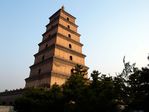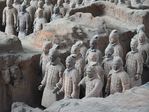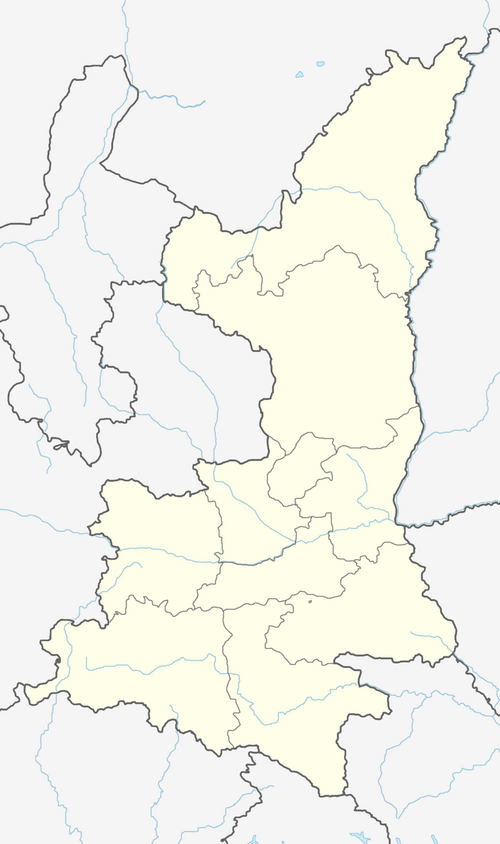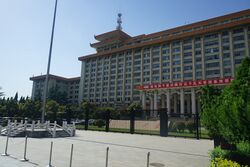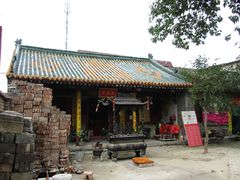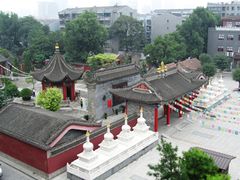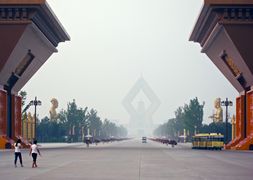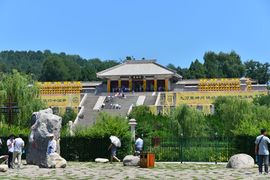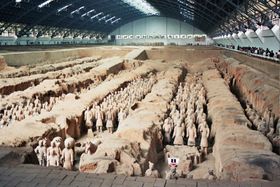شآنشي
Shaanxi
陕西 | |
|---|---|
| الترجمة اللفظية بالـ Name | |
| • Chinese | 陕西省 (Shǎnxī Shěng) |
| • Abbreviation | SN / 陕 or 秦 (pinyin: Shǎn / Qín) |
(clockwise from top)
| |
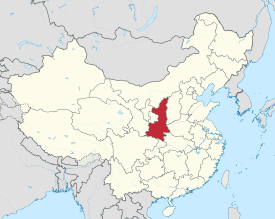 Map showing the location of Shaanxi Province | |
| الإحداثيات: 35°36′N 108°24′E / 35.6°N 108.4°E | |
| Country | China |
| Capital (and largest city) | Xi'an |
| Divisions | 10 prefectures، 107 counties، 1745 townships |
| الحكومة | |
| • النوع | Province |
| • الكيان | Shaanxi Provincial People's Congress |
| • CCP Secretary | Liu Guozhong |
| • Congress chairman | Liu Guozhong |
| • Governor | Zhao Yide |
| • CPPCC chairman | Xu Xinrong |
| المساحة | |
| • الإجمالي | 205٬800 كم² (79٬500 ميل²) |
| ترتيب المساحة | 11th |
| أعلى منسوب | 3٬771 m (12٬372 ft) |
| التعداد (2020)[2] | |
| • الإجمالي | 39٬530٬000 |
| • الترتيب | 16th |
| • الكثافة | 190/km2 (500/sq mi) |
| • ترتيب الكثافة | 21st |
| Demographics | |
| • Ethnic composition | Han – 99.5% Hui – 0.4% |
| • Languages and dialects | Zhongyuan Mandarin, Southwestern Mandarin, Jin |
| ISO 3166 code | CN-SN |
| GDP (2020) | CNY 2.618 trillion USD 380 billion (14th)[3] |
| - per capita | CNY 66,234 USD 9,599 (14th) |
| • growth | ▲ 2.2% |
| HDI (2019) | ▲ 0.762[4] high · 13th |
| الموقع الإلكتروني | www.shaanxi.gov.cn (Simplified Chinese) |
| شآنشي | |||||||||||||||||||||||||||||||||||||
|---|---|---|---|---|---|---|---|---|---|---|---|---|---|---|---|---|---|---|---|---|---|---|---|---|---|---|---|---|---|---|---|---|---|---|---|---|---|
 "Shaanxi" in Simplified (top) and Traditional (bottom) Chinese characters | |||||||||||||||||||||||||||||||||||||
| الاسم الصيني | |||||||||||||||||||||||||||||||||||||
| الصينية المبسطة | 陕西 | ||||||||||||||||||||||||||||||||||||
| الصينية التقليدية | 陝西 | ||||||||||||||||||||||||||||||||||||
| Hanyu Pinyin | Shǎnxī | ||||||||||||||||||||||||||||||||||||
| البريد | Shensi | ||||||||||||||||||||||||||||||||||||
| المعنى الحرفي | "West of the Shǎn (Pass)" | ||||||||||||||||||||||||||||||||||||
| |||||||||||||||||||||||||||||||||||||
| Dunganese name | |||||||||||||||||||||||||||||||||||||
| دونگان | Шанщи | ||||||||||||||||||||||||||||||||||||
شآنشي (simplified Chinese: 陕 西; traditional Chinese: 陝 西; pinyin: Shǎnxī; Wade–Giles: Shan-hsi; تهجي الخريطة البريدية: Shensi) هي مقاطعة في منطقة شمال غرب الصين من جمهورية الصين الشعبية، وتضم أجزاءً من هضبة لوس في الجزء الأوسط من مجرى النهر الأصفر وكذلك جبال چينلينگ عبر الجزء الجنوبي من المقاطعة. وهي الموطن التاريخي، مع گانسو، للهجة الدونگان، الذين هم من الهوي الذين هاجروا إلى آسيا الوسطى.
Shaanxi covers an area of over 205,000 km2 (79,151 sq mi) with about 37 million people, the 16th highest in China. Xi'an – which includes the sites of the former Chinese capitals Fenghao and Chang'an – is the provincial capital as well as the largest city in Northwest China[5] and also one of the oldest cities in China and the oldest of the Four Great Ancient Capitals, being the capital for the Western Zhou, Western Han, Jin, Sui and Tang dynasties.[6] Xianyang, which served as the Qin dynasty capital, is just north across Wei River. The other prefecture-level cities into which the province is divided are Ankang, Baoji, Hanzhong, Shangluo, Tongchuan, Weinan, Yan'an and Yulin.
Shaanxi is geographically divided into three parts, namely Northern, Central and Southern Shaanxi. Northern Shaanxi (or "Shaanbei") makes up the southeastern portion of the Ordos Basin, and mainly comprises the two prefectural cities of Yulin and Yan'an on the northern Loess Plateau, demarcated from the Ordos Desert and the grasslands of Inner Mongolia's Ordos City by the Ming Great Wall. Central Shaanxi (or "Shaanzhong") is also known as the Guanzhong region, and comprises the drainage basin of lower Wei River east of Mount Long and north of the Qinling Mountains, where the majority of Shaanxi's population reside. Southern Shaanxi (or "Shaannan") comprises of the three prefectural cities in the edge of the historical Bashu region south of the Qinling Mountains, and includes the three mountainous cities of Hanzhong, Ankang and Shangluo. Along with areas of adjacent Shanxi and Henan provinces, it formed the cradle of Chinese civilization.
The vast majority of the population of Shaanxi is Han Chinese. Mandarin is mainly spoken in Shaanxi, including Zhongyuan Mandarin and Southwestern Mandarin; another variety of Chinese, Jin, is also spoken.
Shaanxi is China's 15th largest economy, ranking within the middle among China's administrative divisions. The fossil fuel and high technology sectors compose the two largest industries in Shaanxi Province. The high technology sector includes aircraft and aerospace industries, and Shaanxi produces more than 50% of the R&D and manufacturing equipment for the country's domestic commercial aviation industry.[7]
الاسم
The name "Shaanxi" is an irregular romanization of the Mandarin pronunciation of the Chinese name 陕西, meaning "[Land] West of the Shan Pass". This pass in Henan, now part of Sanmenxia's Shanzhou District, was considered to be the place where the Yellow River left the Loess Plateau and entered the North China Plain.
Because the Mandarin pronunciation of Shaanxi and its eastern neighbor Shanxi differs only in tone, their spelling in pinyin romanization differs only by tone marks (Shǎnxī and Shānxī, respectively). The People's Republic of China therefore adopted the special official spelling "Shaanxi". The first syllable is derived from Gwoyeu Romatzyh romanization[بحاجة لمصدر], which reflects the tones of the words' vowels in their spelling.[8] Before the adoption of pinyin, Shaanxi was romanized as Shensi in the Chinese postal romanization scheme. When tone marks are noted, it is spelled Shǎnxī rather than Shǎanxī or Shaǎnxī.
The Shaanxi–Shanxi ambiguity only occurs in Mandarin and other northern varieties of Chinese that have lost the -m syllable ending. In Cantonese, for example, the two provinces' names are Sím-sāi and Sāan-sāi, and in Hokkien they are Siám-sai and Soaⁿ-sai.
The name first appeared as a lu (circuit) established by the Song dynasty in 997.[9]
التاريخ
Shaanxi is considered one of the cradles of Chinese civilization. Thirteen feudal dynasties established their capitals in the province during a span of more than 1,100 years, from the Zhou dynasty to the Tang dynasty.
The province's principal city and current capital, Xi'an, is one of the four great ancient capitals of China and is the eastern terminus of the Silk Road, which leads to Europe, the Arabian Peninsula and Africa.
Under the Han dynasty, the Northern Silk Road was expanded to advance exploration and military purposes to the west. This Northern Silk Road is the northernmost of the Silk Roads and is about 2,600 kilometres (1,600 mi) in length. It connected the ancient Chinese capital of Xi'an to the west over the Wushao Ling Pass to Wuwei and emerging in Kashgar before linking to ancient Parthia.[10]
The Northern Song dynasty established a Shaanxi Lu, (circuit) in the area, governed from modern Xi'an in 997. The Yuan dynasty established Shaanxi Province (Yuan dynasty), governed by a Branch Secretariat in 1286.[9]
Under the Ming dynasty, Shaanxi was established with the founding of the Saanxi Provincial Administration Commission in 1376, whose administration also included the modern provinces of Gansu, Ningxia, and part of Qinghai.[9]
One of the most devastating earthquakes in history occurred near Hua Shan, in south-eastern part of Shaanxi Province on January 23, 1556, killing an estimated 830,000 people (see 1556 Shaanxi earthquake).
After the founding of the Qing dynasty, Gansu was split from Shaanxi, but both provinces were governed under the Viceroy of Shaan-Gan.
The end of the short-lived Jiangxi Soviet signaled the beginning of the Long March by Mao Zedong and the Chinese Communists to the Shaanxi Soviet at Yan'an.
موقع من قبل التاريخ
The Lantian Man site, with hominin fossils of one million years ago, was found in Lantian County in northwestern Shaanxi province, near the city of Xi'an. Scientists classify Lantian Man as a subspecies of Homo erectus. The fossils are displayed at the Shaanxi History Museum, Xi'an, China.
الجغرافيا
The geography of the area is described as being part of the Ordos Desert in the north along the border with Inner Mongolia, the Loess Plateau in the central part of the province, the Qin Mountains (Qinling) running east to west in the south central part, and subtropical climate south of the Qinling. In between the Loess Plateau and the Qinling lies the Wei River Valley, or Guanzhong, a cradle of early Chinese civilization.
Going clockwise, Shaanxi borders Shanxi (E, NE), Henan (E), Hubei (SE), Chongqing (S), Sichuan (SW), Gansu (W), Ningxia (NW), and Inner Mongolia (N). In terms of number of bordering provincial-level divisions, Shaanxi ties Inner Mongolia.
Due to its large span in latitude, Shaanxi has a variety of climates. Under the Köppen climate classification, the northern parts, including the Loess Plateau, have either a cold arid (Köppen BWk) or cold semi-arid (Köppen BSk), with cold and very dry winters, dry springs and autumns, and hot summers. The area known as Guanzhong is mostly semi-arid, though there are a few areas with a humid subtropical climate (Köppen Cwa), with cool to cold winters, and hot, humid summers that often see early-season heatwaves. The southern portion is much more humid and lies in the humid subtropical zone, with more temperate winters and long, hot, humid summers. Annual mean temperature is roughly between 8 to 16 °C (46 to 61 °F), with January temperatures ranging from −11 to 3.5 °C (12.2 to 38.3 °F) and July temperatures ranging from 21 to 28 °C (70 to 82 °F).
Besides the provincial capital of Xi'an, other cities include: Baoji, Hanzhong, Lintong, Tongchuan, Xianyang, Yan'an and Ankang.
التقسيمات الادارية
Shaanxi consists of ten prefecture-level divisions: all prefecture-level cities (including a sub-provincial city):
| Administrative divisions of Shaanxi | ||||||||||
|---|---|---|---|---|---|---|---|---|---|---|
| Division code[11] | Division | Area in km2[12] | Population 2010[13] | Seat | Divisions[14] | |||||
| Districts | Counties | CL cities | ||||||||
| 610000 | Shaanxi Province | 205800.00 | 37,327,378 | Xi'an city | 30 | 71 | 6 | |||
| 610100 | Xi'an city | 10096.81 | 8,467,837 | Weiyang District | 11 | 2 | ||||
| 610200 | Tongchuan city | 3884.81 | 834,437 | Yaozhou District | 3 | 1 | ||||
| 610300 | Baoji city | 18116.93 | 3,716,731 | Jintai District | 3 | 9 | ||||
| 610400 | Xianyang city | 10323.99 | 4,894,834 | Qindu District | 3 | 9 | 2 | |||
| 610500 | Weinan city | 13030.56 | 5,286,077 | Linwei District | 2 | 7 | 2 | |||
| 610600 | Yan'an city | 37030.54 | 2,187,009 | Baota District | 2 | 10 | 1 | |||
| 610700 | Hanzhong city | 27096.43 | 3,416,196 | Hantai District | 2 | 9 | ||||
| 610800 | Yulin city | 42920.18 | 3,351,437 | Yuyang District | 2 | 9 | 1 | |||
| 610900 | Ankang city | 23536.31 | 2,629,906 | Hanbin District | 1 | 9 | ||||
| 611000 | Shangluo city | 19587.31 | 2,341,742 | Shangzhou District | 1 | 6 | ||||
| Administrative divisions in Chinese and varieties of romanizations | ||||
|---|---|---|---|---|
| English | Chinese | Pinyin | ||
| Shaanxi Province | 陕西省 | Shǎnxī Shěng | ||
| Xi'an city | 西安市 | Xī'ān Shì | ||
| Tongchuan city | 铜川市 | Tóngchuān Shì | ||
| Baoji city | 宝鸡市 | Bǎojī Shì | ||
| Xianyang city | 咸阳市 | Xiányáng Shì | ||
| Weinan city | 渭南市 | Wèinán Shì | ||
| Yan'an city | 延安市 | Yán'ān Shì | ||
| Hanzhong city | 汉中市 | Hànzhōng Shì | ||
| Yulin city | 榆林市 | Yúlín Shì | ||
| Ankang city | 安康市 | Ānkāng Shì | ||
| Shangluo city | 商洛市 | Shāngluò Shì | ||
The ten prefecture-level cities of Shaanxi are subdivided into 107 county-level divisions (30 districts, 4 county-level cities, and 73 counties).
Urban areas
| Population by urban areas of prefecture & county cities | |||||
|---|---|---|---|---|---|
| # | City | Urban area[15] | District area[15] | City proper[15] | Census date |
| 1 | Xi'an[أ] | 5,206,253 | 6,501,190 | 8,467,838 | 2010-11-01 |
| (1) | Xi'an (new districts)[أ] | 389,830 | 889,854 | see Xi'an | 2010-11-01 |
| 2 | Baoji | 871,940 | 1,437,802 | 3,716,737 | 2010-11-01 |
| 3 | Xianyang[ب] | 730,704 | 945,420 | 5,096,001 | 2010-11-01 |
| 4 | Tongchuan | 463,866 | 743,277 | 834,437 | 2010-11-01 |
| 5 | Yulin[ت] | 429,189 | 637,617 | 3,351,436 | 2010-11-01 |
| (5) | Yulin (new district)[ت] | 114,188 | 288,053 | see Yulin | 2010-11-01 |
| 6 | Ankang | 379,707 | 870,126 | 2,629,906 | 2010-11-01 |
| 7 | Hanzhong[ث] | 350,167 | 534,923 | 3,416,196 | 2010-11-01 |
| (7) | Hanzhong (new district)[ث] | 144,596 | 471,634 | see Hanzhong | 2010-11-01 |
| 8 | Weinan[ج] | 347,484 | 877,142 | 5,286,077 | 2010-11-01 |
| (8) | Weinan (new district)[ج] | 107,467 | 322,148 | see Weinan | 2010-11-01 |
| 9 | Yan'an[ح] | 336,856 | 475,234 | 2,187,009 | 2010-11-01 |
| (9) | Yan'an (new district)[ح] | 74,945 | 171,552 | see Yan'an | 2010-11-01 |
| (10) | Shenmu[خ] | 282,650 | 455,493 | see Yulin | 2010-11-01 |
| 11 | Xingping | 247,539 | 541,554 | see Xianyang | 2010-11-01 |
| 12 | Hancheng | 196,574 | 391,164 | see Weinan | 2010-11-01 |
| 13 | Shangluo | 156,781 | 531,696 | 2,341,742 | 2010-11-01 |
| 14 | Huayin | 127,987 | 258,113 | see Weinan | 2010-11-01 |
| (15) | Binzhou[د] | 106,710 | 171,462 | see Xianyang | 2010-11-01 |
| 16 | Yangling[ب] | 104,944 | 201,172 | see Xianyang | 2010-11-01 |
- ^ أ ب New districts established after census: Gaoling (Gaoling County), Huyi (Huxian County). These new districts not included in the urban area & district area count of the pre-expanded city.
- ^ أ ب Yangling is a satellite urban area separated from Xianyang and it is not included in the urban area & district area count.
- ^ أ ب New district established after census: Hengshan (Hengshan County). The new district not included in the urban area & district area count of the pre-expanded city.
- ^ أ ب New district established after census: Nanzheng (Nanzheng County). The new district not included in the urban area & district area count of the pre-expanded city.
- ^ أ ب New district established after census: Huazhou (Huaxian County). The new district not included in the urban area & district area count of the pre-expanded city.
- ^ أ ب New district established after census: Ansai (Ansai County). The new district not included in the urban area & district area count of the pre-expanded city.
- ^ Shenmu County is currently known as Shenmu CLC after census.
- ^ Binxian County is currently known as Binzhou CLC after census.
السياسة
The politics of Shaanxi is structured in a triple party-government system like all other governing institutions in mainland China.
The Governor of Shaanxi is the highest-ranking official in the People's Government of Shaanxi. However, in the province's dual party-government governing system, the Governor is considered to have less power than the Shaanxi Chinese Communist Party Provincial Committee Secretary (中共陕西省委书记), colloquially termed the "Shaanxi CCP Party Chief"; since the Governor is always ranked as the First-Deputy Secretary in the Shaanxi Chinese Communist Party Provincial Committee.
Shaanxi was established as a provincial government since Qing dynasty. On 10 January 1950, the People's Government of Shaanxi was established in Xi'an. Ma Minfang was then appointed as the first Governor of Shaanxi.
الاقتصاد
As of the mid-19th century, Shaanxi exported animal skins, wine, liquor, and musk. Money loans were also common, with Shaanxi business people involved in the Guangzhou loan business. Shaanxi commonly imported European animal skins, watches, Chinese language books, and cloth.[16]
The fossil fuel and high technology sectors compose the two largest industries in Shaanxi province. During 2009, the province ranked third in China for production of coal, natural gas and crude oil.[7] As the home of several of the leading universities and research institutes in Western China, Shaanxi province also plays a major role in China's burgeoning aircraft and aerospace industries, producing more than 50% of the R&D and manufacturing equipment for the country's domestic commercial air industry.[7] Nominal GDP for 2011 was 1,239 billion RMB (US$196.7 billion) and GDP per capita was 21,729 RMB (US$3,179), ranking 17th in the PRC.
In the first half of 2019, Shaanxi's total production value reached 1,162.557 billion yuan, a year-on-year increase of 5.4%. The added value of the primary industry was 55.319 billion yuan, an increase of 4.5%; the second industry was 557.935 billion yuan, an increase of 4.2%; the tertiary industry was 549.303 billion yuan, an increase of 6.8%.[17]
الديمغرافيا
Nearly all the people in Shaanxi are ethnic Han Chinese, with pockets of Hui population in the northwestern region (adjacent to Ningxia). Shaanxi province is one of the centers of ancient Chinese civilization. The southern part of Shaanxi, known as Guanzhong, where the provincial capital Xi'an is located, is more populated compared to the northern part.
|
| ||||||||||||||||||||||||||||||||||||
| Xi'an part of Shaanxi Province until 1947; dissolved in 1954 and incorporated into Shaanxi Province. | |||||||||||||||||||||||||||||||||||||
الأديان
Religion in Shaanxi[28][note 1]
The predominant religions in Shaanxi are Chinese folk religions, Taoist traditions and Chinese Buddhism. According to surveys conducted in 2007 and 2009, 7.58% of the population believes and is involved in ancestor veneration, while 1.57% of the population identifies as Christian.[28] The reports didn't give figures for other types of religion; 90.85% of the population may be either irreligious or involved in worship of nature deities, Buddhism, Confucianism, Taoism, folk religious sects, and small minorities of Muslims.
|
- Catholic Church in Shaanxi
- Catholic Church in Zhifang, destroyed in 2017
- Golden Lampstand Church, destroyed in 2018
الثقافة
- Qinqiang, the representative folk opera of Shaanxi.
- انظر أيضاً شيآن#الثقافة
السياحة
- بانپو، القرية من العصر الحجري الحديث، بالقرب من شيآن
- پاگودا داچين
- الأضرحة الإمبراطورية
- ضريح ژاو
- هواشان (جبل هوا)، أحد الجبال الخمس الأكثر شهرة في الصين.
- تايبايشان (جبل تايباي)، أعلى قمة في سلسلة جبال چينلينگ.
- الضريح ومتحف الجيش الجصي لأول امبراطور من أسرة چين في شيآن (موقع تراث عالمي)
- مدينة شيآن: أسوار المدينة، المسجد الجامع، برج الجرس وبرج الطبلة، متحف غابة النصب الحجرية، متحف تاريخ شآنشي، پاگودا الأوزة البرية
- يانآن، مقصد المسيرة الطويلة ومركز الثورة الشيوعية الصينية من 1935 حتى 1948
- شعرية بيانگ بيانگ، أحد "أغرب عشر عجائب في شآنشي" (陝西十大怪)
انظر أيضاً
تذييل
- ^ The data was collected by the Chinese General Social Survey (CGSS) of 2009 and by the Chinese Spiritual Life Survey (CSLS) of 2007, reported and assembled by Xiuhua Wang (2015)[28] in order to confront the proportion of people identifying with two similar social structures: ① Christian churches, and ② the traditional Chinese religion of the lineage (i. e. people believing and worshipping ancestral deities often organised into lineage "churches" and ancestral shrines). Data for other religions with a significant presence in China (deity cults, Buddhism, Taoism, folk religious sects, Islam, et. al.) was not reported by Wang.
- ^ This may include:
- Buddhists;
- Confucians;
- Deity worshippers;
- Taoists;
- Members of folk religious sects;
- Small minorities of Muslims;
- And people not bounded to, nor practicing any, institutional or diffuse religion.
الهامش
- ^ "Doing Business in China – Survey". Ministry of Commerce of the People's Republic of China. Archived from the original on 26 May 2014. Retrieved 5 August 2013.
- ^ "Communiqué of the Seventh National Population Census (No. 3)". National Bureau of Statistics of China. 11 May 2021. Retrieved 11 May 2021.
{{cite web}}: CS1 maint: url-status (link) - ^ GDP-2020 is a preliminary data "Home - Regional - Quarterly by Province" (Press release). China NBS. March 1, 2021. Retrieved March 23, 2021.
- ^ "Sub-national HDI - Subnational HDI - Global Data Lab". globaldatalab.org. Retrieved 2020-04-17.
- ^ 最新中国城市人口数量排名(根据2010年第六次人口普查). www.elivecity.cn (in Chinese (China)). Archived from the original on 2015-03-03. Retrieved 2019-06-12.
- ^ "Xi'an - MSN Encarta". 2008-02-28. Archived from the original on 2008-02-28. Retrieved 2019-06-12.
- ^ أ ب ت "China Economy @ China Perspective". Archived from the original on 2011-10-08. Retrieved 2011-10-25.
- ^ "The State Council of the People's Republic of China". Archived from the original on 2010-02-12. Retrieved 2006-12-29.
- ^ أ ب ت Dictionary of the Ben cao gang mu, Volume 2: Geographical and Administrative Designations First Edition, Paul Unschuld, Series Editor Edition by Hua Linfu (Author), Paul D. Buell (Author), Paul U. Unschuld (Editor)
- ^ "Silk Road, North China, C.Michael Hogan, the Megalithic Portal, ed. A. Burnham". Archived from the original on 2013-10-02. Retrieved 2007-12-26.
- ^ 中华人民共和国县以上行政区划代码 (in الصينية المبسطة). Ministry of Civil Affairs. Archived from the original on 2015-04-02. Retrieved 2015-12-11.
- ^ Shenzhen Bureau of Statistics. 《深圳统计年鉴2014》 (in الصينية المبسطة). China Statistics Print. Archived from the original on 2015-05-12. Retrieved 2015-05-29.
- ^ Census Office of the State Council of the People's Republic of China; Population and Employment Statistics Division of the National Bureau of Statistics of the People's Republic of China (2012). 中国2010人口普查分乡、镇、街道资料 (1 ed.). Beijing: China Statistics Print. ISBN 978-7-5037-6660-2.
- ^ Ministry of Civil Affairs (August 2014). 《中国民政统计年鉴2014》 (in الصينية المبسطة). China Statistics Print. ISBN 978-7-5037-7130-9.
- ^ أ ب ت 国务院人口普查办公室、国家统计局人口和社会科技统计司编 (2012). 中国2010年人口普查分县资料. Beijing: China Statistics Print. ISBN 978-7-5037-6659-6.
- ^ Roberts, Edmund (1837). Embassy to the Eastern Courts of Cochin-China, Siam, and Muscat. New York: Harper & Brothers. p. 123. Archived from the original on 2013-10-16. Retrieved 2013-10-16.
- ^ "Shaanxi GDP in 1st Half of 2019: Up by 5.4% – Cilitech". cilitech.com. Archived from the original on 2019-07-31. Retrieved 2019-07-31.
- ^ 1912年中国人口. Archived from the original on 24 September 2015. Retrieved 6 March 2014.
- ^ 1928年中国人口. Archived from the original on 24 September 2015. Retrieved 6 March 2014.
- ^ 1936–37年中国人口. Archived from the original on 24 September 2015. Retrieved 6 March 2014.
- ^ 1947年全国人口. Archived from the original on 13 September 2013. Retrieved 6 March 2014.
- ^ 中华人民共和国国家统计局关于第一次全国人口调查登记结果的公报. National Bureau of Statistics of China. Archived from the original on 2009-08-05.
- ^ 第二次全国人口普查结果的几项主要统计数字. National Bureau of Statistics of China. Archived from the original on 2012-09-14.
- ^ 中华人民共和国国家统计局关于一九八二年人口普查主要数字的公报. National Bureau of Statistics of China. Archived from the original on 2012-05-10.
- ^ 中华人民共和国国家统计局关于一九九〇年人口普查主要数据的公报. National Bureau of Statistics of China. Archived from the original on 2012-06-19.
- ^ 现将2000年第五次全国人口普查快速汇总的人口地区分布数据公布如下. National Bureau of Statistics of China. Archived from the original on 2012-08-29.
- ^ "Communiqué of the National Bureau of Statistics of People's Republic of China on Major Figures of the 2010 Population Census". National Bureau of Statistics of China. Archived from the original on 2013-07-27.
- ^ أ ب ت China General Social Survey 2009, Chinese Spiritual Life Survey (CSLS) 2007. Report by: Xiuhua Wang (2015, p. 15) Archived 2015-09-25 at the Wayback Machine
وصلات خارجية
- Official website (in صينية)
- Economic profile for Shaanxi at HKTDC
- Pages using gadget WikiMiniAtlas
- CS1 maint: url-status
- CS1 uses الصينية-language script (zh)
- CS1 Chinese (China)-language sources (zh-cn)
- CS1 الصينية المبسطة-language sources (zh-hans)
- CS1 uses اليابانية-language script (ja)
- Short description is different from Wikidata
- Articles containing صينية-language text
- Coordinates on Wikidata
- Articles containing simplified Chinese-language text
- Articles containing traditional Chinese-language text
- Articles with unsourced statements from November 2017
- Articles with hatnote templates targeting a nonexistent page
- Articles with صينية-language sources (zh)
- شآنشي
- مقاطعات جمهورية الصين الشعبية
- غرب الصين

